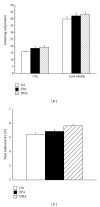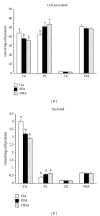Effects of eicosapentaenoic acid and docosahexaenoic acid on chylomicron and VLDL synthesis and secretion in Caco-2 cells
- PMID: 24987699
- PMCID: PMC4058467
- DOI: 10.1155/2014/684325
Effects of eicosapentaenoic acid and docosahexaenoic acid on chylomicron and VLDL synthesis and secretion in Caco-2 cells
Abstract
The present research was undertaken to determine the effects of EPA (20 : 5 n-3) and DHA (22 : 6 n-3) on chylomicron and VLDL synthesis and secretion by Caco-2 cells. Cells were incubated for 12 to 36 h with 400 μM OA, EPA, and DHA; then 36 h was chosen for further study because EPA and DHA decreased de novo triglycerides synthesis in a longer incubation compared with OA (P < 0.01). Neither the uptake nor oxidation was different in response to the respective fatty acids (P > 0.05). Compared with OA, intercellular and secreted nascent apolipoprotein B48 and B100 were decreased by EPA and DHA (P < 0.01). Both DHA and EPA resulted in a lower secretion of chylomicron and VLDL (P < 0.01). In contrast to OA, EPA and DHA were preferentially incorporated into phospholipids instead of triacylglycerols (P < 0.01). These discoveries demonstrated that exposure of DHA and EPA reduced the secretion of chylomicron and VLDL partly by regulating the synthesis of TG and apoB.
Figures






References
-
- Austin MA, Hokanson PJE, Edwards KL. Hypertriglyceridemia as a cardiovascular risk factor. The American Journal of Cardiology. 1998;81:7B–12B. - PubMed
-
- Grundy SM. Hypertriglyceridemia, insulin resistance, and the metabolic syndrome. The American Journal of Cardiology. 1999;83:25–29. - PubMed
-
- Harris WS. Fish oils and plasma lipid and lipoprotein metabolism in humans: a critical review. Journal of Lipid Research. 1989;30(6):785–807. - PubMed
-
- Sanders TAB, Sullivan DR, Reeve J, Thompson GR. Triglyceride-lowering effect of marine polyunsaturates in patients with hypertriglyceridemia. Arteriosclerosis. 1985;5(5):459–465. - PubMed
-
- Homan R, Grossman JE, Pownall HJ. Differential effects of eicosapentaenoic acid and oleic acid on lipid synthesis and secretion by HepG2 cells. Journal of Lipid Research. 1991;32(2):231–241. - PubMed
Publication types
MeSH terms
Substances
LinkOut - more resources
Full Text Sources
Other Literature Sources
Research Materials
Miscellaneous

